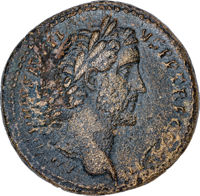020 7636 1188 info [at] coincraft.com
You have no items in your shopping cart.
Roman Bronze Coins
View as
Sort by
Display per page
Filter by attributes
- Currently shopping by:
- Denomination: Antoninianus or Sestertius or Centenionalis or Stater
- Dynasty: Julio-Claudian or Flavian or Nerva-Antonine or Severan or Constantinian or Gallic Empire
Antoninus Pius. A.D. 138-161. Rome - A.D. 144. Æ Sestertius.
Antoninus Pius. A.D. 138-161. Rome - A.D. 144. Æ Sestertius. Laureate head right / 'IMPERATOR II' Victory flying right holding trophy in both hands. About Very Fine & Very Scarce. Imperator a second time for Lollius Urbicus' fighting in Britain!
£435.00
Antoninus Pius. A.D. 138-161., Rome - A.D. 146. Æ Sestertius. COS IIII.
Antoninus Pius. A.D. 138-161., Rome - A.D. 146. Æ Sestertius. Laureate head right / 'COS IIII' Antoninus with radiate nimbus standing left holding branch & spear, 'S-C' in fields. Pleasing Very Fine & Scarce.
£465.00
Bronze Antoninianus from the Normanby Hoard - Available in Different Grades
This hoard of 47,912 Third century A.D. bronze Antoniniani is one of the largest ever found in Britain. It was discovered by a metal detectorist in December 1985 in the parish of Normanby, about twelve miles north of Lincoln. The hoard was delivered to the British Museum for cleaning and study, and was the subject of a Treasure Inquest on 19 May 1987, where it was found not to be Treasure Trove, in view of the low silver content of the coins, and consequently became the property of the land owner. The hoard was immediately sold by the owner to a coin dealer and has been gradually dispersed in the trade. We have been fortunate to acquire a small group of coins from this hoard. The coins were struck between A.D. 260 and 287 and are mostly of Victorinus, Tetricus I, and II. You can have a choice of grades, Fine, Very Fine, or Extremely Fine with prices to please. These Roman coins will be over 1,700 years old soon, they were found in Britain and we will provide you with a certificate of authenticity. Get one for your collection today!
From £19.95
Bronze Antoninianus from the Normanby Hoard Extremely Fine
Bronze Antoninianus in Extremely Fine condition
£47.50
Bronze Antoninianus from the Normanby Hoard Very Fine
Bronze Antoninianus in Very Fine condition
£29.50
Constantine II, Centenionalis 'Cent' Mint State
Constantine II was the eldest son of Constantine the Great, he was Roman Emperor from 337 until his death in 340 AD. After his father’s death, the empire was divided among Constantine II and his brothers, Constantius II and Constans. Constantine II ruled over Gaul, Britannia, and Hispania. His reign was marked by tensions with his brothers, culminating in a failed attempt to assert dominance over Constans’ territories. In 340 AD, Constantine II invaded Italy but was ambushed and killed near Aquileia. His rule was relatively short and tumultuous, overshadowed by the internal strife that characterised the early years of the post-Constantinian empire. Here we are offering his Follis in mint state, a grade which a very difficult grade to find when it comes to 4th century coinage. You can see every bit of detail on these beautiful coins.
£89.50
Constantius I as Caesar. A.D. 293-305., Antioch - A.D. 297. Æ Ant. CONCORDIA MILITVM.
Constantius I as Caesar. A.D. 293-305., Antioch - A.D. 297. Æ Ant. Radiate head right / 'CONCORDIA MILITVM' Constantius receiving Victory on globe from Jupiter. Good Fine.
£65.00
Domitian AD 81-96, AE Sestertius, IOVI VICTORI Rome AD 90-91
Domitian AD 81-96, AE Sestertius, Rome AD 90-91. Obverse: Laureate head right. Reverse: IOVI VICTORI, Jupiter seated left holdng Victory and sceptre, S C below in exergue. Good Very Fine, a well centred and well struck up coin, a little surface pitting evident.
£895.00
Hadrian. A.D. 117-138. Rome - A.D. 138. Æ Sestertius, Rev. Diana S-C.
Hadrian, AD 117-138. Rome AD 138. Æ Sestertius. Obv. Laureate head right. Rev. Diana (goddess of the hunt) standing left holding bow & arrow; 'S-C' across fields. Extremely Fine & Scarce with a wonderful bold portrait, well centred with full legends. From an old collection with tickets. [RIC 777, Sear 3645]
£495.00
Hadrian. A.D. 117-138., Rome - A.D. 135. Æ Sestertius. AEQ[VITA]S AVG.
Hadrian. A.D. 117-138., Rome - A.D. 135. Æ Sestertius. Laureate head right / 'AEQ[VITA]S AVG' Aequitas standing left holding scales & sceptre. About Very Fine.
£285.00
Julia Mamaea, Mother of S. Alexander., Æ Sestertius.
Julia Mamaea, Mother of S. Alexander., Æ Sestertius. Vesta stg. Good Very Fine & Scarce.
£190.00
Vespasian. A.D 69-79. Rome - A.D. 71. Æ Sestertius. PAX AVGVSTI.
Vespasian. A.D 69-79. Rome - A.D. 71. Æ Sestertius. Laureate head of Vespasian right / 'PAX AVGVSTI' Pax standing left holding olive branch & cornucopiae. Good Very Fine/Very Fine & Scarce. Comes with auction envelope from 1934. Part of a series struck to celebrate peace after 5 years of war that almost broke the empire.
£725.00

































![Show details for Hadrian. A.D. 117-138., Rome - A.D. 135. Æ Sestertius. AEQ[VITA]S AVG. Hadrian. A.D. 117-138., Rome - A.D. 135. Æ Sestertius. AEQ[VITA]S AVG_obv](https://coincraft.com/images/thumbs/002/0025060_hadrian-ad-117-138-rome-ad-135-sestertius-aeqvitas-avg_200.jpeg)




